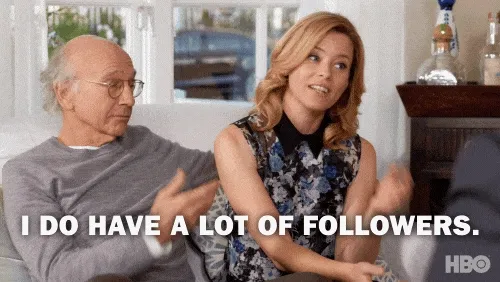Social followers aren’t just for vanity
The old adage just isn't true. Your brand should want more followers.

Curb Your Enthusiam/HBO via Giphy
• 5 min read
Remember the opening scene of The Newsroom? Where Jeff Daniels, with perfect Sorkin smugness, rants about how America isn’t the greatest country in the world? That’s how I feel when I talk about this topic:
Follower count is not a vanity metric.
I can already hear you screaming in protest, so let’s dig in.
What’s a vanity metric?
Let’s start with a few definitions so we understand what we’re debating.
Here’s Hubspot’s take:
“Vanity metrics include data such as social media followers, page views, subscribers, and other flashy analytics that are satisfying on paper, but don’t move the needle for your business goals. They offer positive reporting, but no context for future marketing decisions—something actionable metrics can do.
I’ve got a lot of issues with that take, but let’s check another source.
Business intelligence company Tableau defines vanity metrics as “metrics that make you look good to others but do not help you understand your own performance in a way that informs future strategies.”
Okay, that’s more conceptually clean. I’ll spare you the other definitions I dug through, but the gist of it is that to most, vanity metrics feel more showy or braggadocious, less helpful.
Why does everyone say follower count is a vanity metric?
Because a long time ago, back when social analytics were brand-spankin’-new and social pros mostly worked on Facebook, social just wasn’t as scientific as it is now.
Senior executives knew they had to care about social media, but weren’t sure what that meant. And to be fair, neither did social media professionals! Social was a new field. We all made up best practices on the fly, then adjusted 15 minutes later when the algorithms shifted or a new network emerged—because that’s just how social works.
So, when those execs needed flashy numbers to pop into presentations, they turned to their usual: growth. It’s always the go-to metric—sales growth, subscriber growth, etc. Followers never have been the full story, but that was the easiest metric to understand way back when.
Social managers needed a way to battle back, and that’s where the “vanity metric” designation came in handy. By calling follower count a vanity metric, we tarnished its reputation for the greater good, in favor of better, more actionable metrics that show the power of social media at every stage of the consumer journey.
It helped foster a better generation of social analytics, but now we’ve overcorrected to disregard follower counts.
Follower count is not a vanity metric, it’s an important metric that you should absolutely care about. No, it shouldn’t be viewed in a vacuum, but it absolutely should be considered when judging the effectiveness of a full-scale social media strategy.
Get marketing news you'll actually want to read
Marketing Brew informs marketing pros of the latest on brand strategy, social media, and ad tech via our weekday newsletter, virtual events, marketing conferences, and digital guides.
Why should a brand put efforts into follower growth?
This one’s just the marketing funnel.
A brand will only ever convert a certain percentage of your followers into purchasers. A wider marketing funnel means more followers to create content for, to engage with, and to push to purchase.
I’d argue that if a brand believes their organic social team is effective, constantly wanting to increase follower growth is a smart move. After all, it means more followers for that social team to convert against.
How can a brand optimize organic content for growth?
On social networks like Instagram and Twitter, content is primarily pushed to followers—people who’ve elected to follow the account. Some platforms offer suggested content pages or algorithmic recommendations, but that’s still marginal.
That means to use organic content to drive follower growth, it needs to be optimized for shares first, with an eye towards proving why the brand is worth following within the content.
Take the Washington Post’s Instagram account. While its amazing TikTok wins all sorts of creative awards, the Instagram operates off an entirely different social strategy and creative tone that earned 1.2 million new followers in the last 12 months.
An interview between Adweek and Travis Lyles, the Post’s deputy director for social and off-platform curation, speaks to a growth and share focused strategy:
“First, rather than fixate on likes, comments or other indicators of engagement, the Post treats shares as its north star metric.”
“When an Instagram user shares a piece of content, that suggests they found it useful––a powerful signal and one that the Post attempts to evoke throughout its reporting, Lyles said. To encourage sharing, the publisher actively considers how to make each post as shareable as possible, a strategy that leans into the ease of discoverability that the platform is known for.”
The important takeaway: They’re optimizing for shareability over likes, comments, and other engagement. Some might argue that’s not a strong community-building stance, but I’d suggest if content has high shareability, it means it’s eliciting a strong emotion, which will take care of generating user comments.
Aren’t there better metrics for social media effectiveness?
Every brand has different immediate needs, different budgets and bandwidths, and different directives for their social media managers. Ultimately, the goals chat should be between a social media manager / team and the brand team, giving the social folks the chance to align or suggest different goals.
I’m essentially suggesting that organic content teams who fight against follower growth as a metric should cool their jets. Growth is important. Of course it is.
Get marketing news you'll actually want to read
Marketing Brew informs marketing pros of the latest on brand strategy, social media, and ad tech via our weekday newsletter, virtual events, marketing conferences, and digital guides.